Author’s note: My goal here isn’t to list EVERY set with Traded cards. In many cases, the set I highlight will stand in for similar issues across a number of years, before and after.
1981 Topps Traded
The first Traded set I became aware of as a young collector was in 1981. At the time the main excitement for me was that Fernando Valenzuela finally got an entire Topps card to himself. Of course, as the name suggested, it was also a chance to see players depicted on their new teams, such as this Dave Winfield card portraying him in a Yankees uniform.
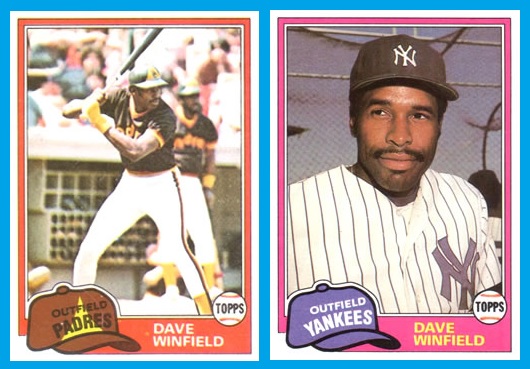
Dozens of similar Traded or Update sets followed in the coming years, leaning considerably on the 1981 Topps Traded set as a model. However, 1981 was definitely not the beginning of the Traded card era.
1979 O-Pee-Chee/Burger King
My first encounter with O-Pee-Chee cards was in 1979. While most of the cards in the 1979 O-Pee-Chee set had fronts that–logo aside–looked exactly like their U.S. counterparts, every now and then an O-Pee-Chee required a double-take. Back here in the US, I was not yet familiar with the 1979 Topps Burger King issue, but they took things even a step further.
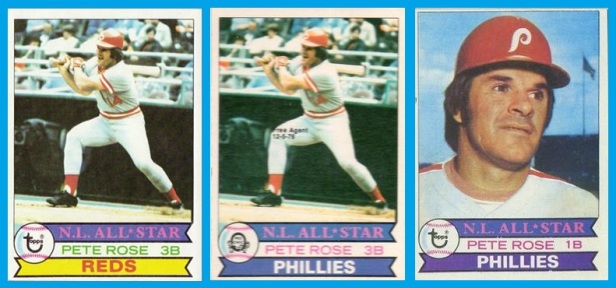
1979 Topps Bump Wills
Not really a traded card, but here is one that at least might have looked like one to collectors in 1979. Having been a young collector myself that year, I can definitely say Bump and hometown hero Steve Garvey were THE hot cards my friends and I wanted that year.
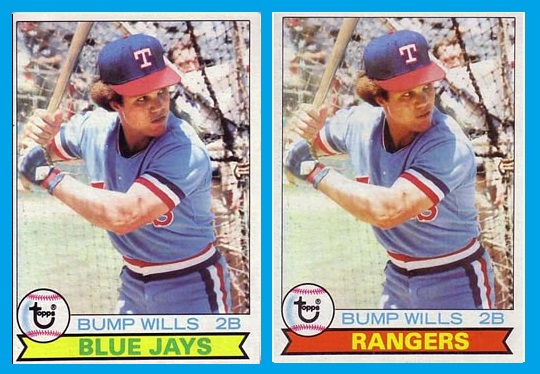
1979 and 1977 Kellogg’s
The most fun Trades cards are ones where the player gets a genuinely new picture in his new uniform like the 1981 Topps Traded Dave Winfield. Next in line behind those are the ones where the team name on the card front changes, such as with the 1979 O-Pee-Chee Pete Rose. Distinctly less exciting but still intriguing are cards were a “Traded line” is added. We will see some sets where such a line makes the front of the card, but much more often we’ll see it as part of the small print on the back.
Here is Buddy Bell’s card from the 1979 set.
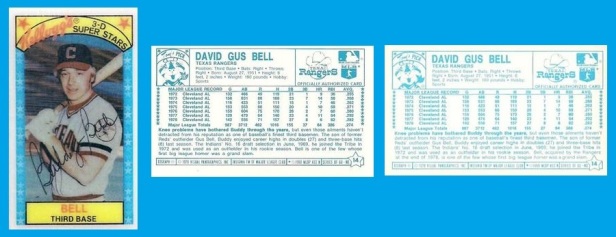
And here is Ken Reitz from the 1977 set.
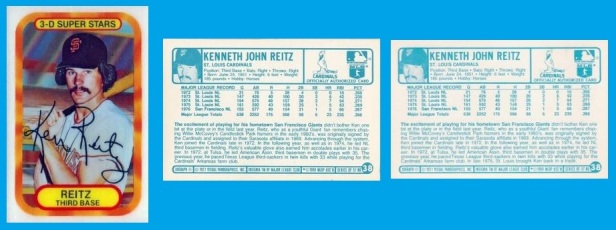
In case it’s a tough read for your eyes, the second version of the Reitz back, at the very end of the bio, reads, “St. Louis brought Ken back in a trade.” The Bell card has a similar statement. Admittedly these cards are a bit bizarre in that the card backs already have the players on their new teams, even in the initial release. Because of that, one could make an argument that the second versions are less Traded cards than “updated bio” cards, but let’s not split hairs. However, you slice it two Reitz don’t make a wrong!
1977 Topps
Not really a Traded card but a great opportunity to feature a rare 1977 proof card of Reggie Jackson as an Oriole, alongside his Topps and Burger King cards of the same year.
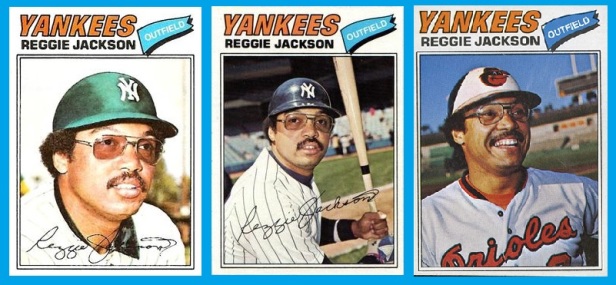
1976 Topps Traded
This set features my favorite design ever in terms of highlighting the change of teams. Unlike the 1981 Topps Traded set, these cards were available in packs and are considered no more scarce than the standard cards from the 1976 Topps set. While the traded cards feature only a single Hall of Famer, this subset did give us one of the classic baseball cards of all time.
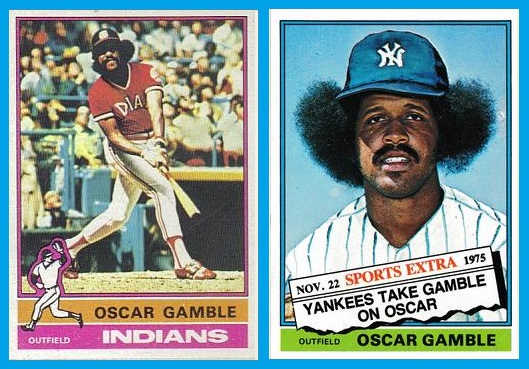
Side note: Along with Ernie Banks, Billy Williams, Lou Brock, Lee Smith, and Joe Carter, Oscar Gamble was “discovered” by the great John Jordan “Buck” O’Neil. Well done, Buck!
1975 and 1976 Kellogg’s
Having already seen the 1977 and 1979 Kellogg’s sets, and now adding two more, I’m starting to think Kellogg’s is a cereal offender–see what I did there–when it comes to card updates. This time, however, the difference goes beyond just the Traded line. Unlike 1977 and 1979, the team name on the back is different also.
First, here is Clay Carroll from 1976.
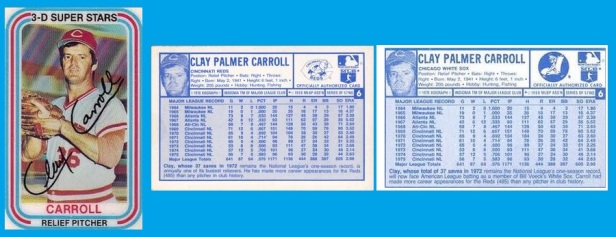
And here is Catfish Hunter from the 1975 set.
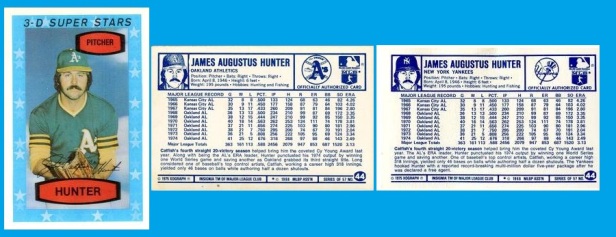
1975 Topps Hank Aaron
Collectors in 1975 were rewarded with two cards of the Home Run King, bookending the classic set as cards #1 and #660. Aaron’s base card depicts the Hammer as a Brewer, the team he would spend his 1975 and 1976 seasons with. Meanwhile, his ’74 Highlights (and NL All-Star) card thankfully portrays Aaron as a Brave.
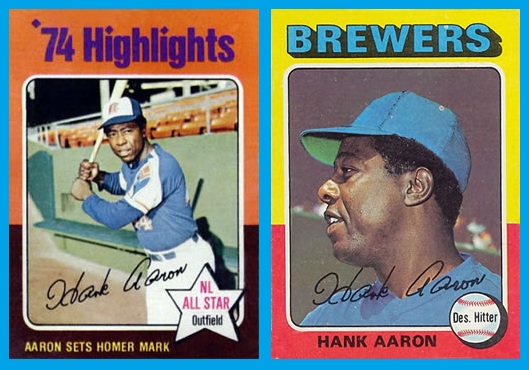
You might be thinking to yourself, “Of course that Highlights/All-Star card shows the Hammer as a Brave. You couldn’t have an NL All-Star on the Brewers, right? (Note to younger collectors: The Brewers were an American League team back in the day.) But put out cards long enough and anything is possible…

1974 Topps – Washington, National League
The National League’s newest team, the San Diego Padres, wasn’t exactly making bank for ownership in San Diego, and it looked like practically a done deal that they would be moving to D.C. for the 1974 season. As the cardboard of record at the time, Topps was all over the expected move and made sure to reflect it on their initial printings of the 1974 set. Because there was no team name yet for the D.C. franchise-to-be, Topps simply went with “Nat’l Lea.” (Click here for a recent SABR Baseball Cards article on the subject.)
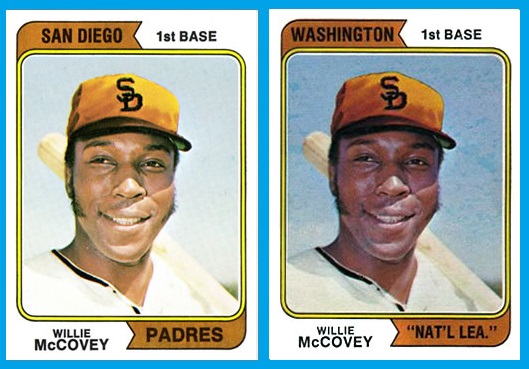
Of course these San Diego/Washington cards aren’t true Traded cards, but that’s not to say there weren’t any in the 1974 Topps set.
1974 Topps Traded
This subset may have been the most direct precursor of the 1981 Topps Traded set. While cards from later printings were randomly inserted in packs, the subset could be purchased in full, assuming you threw down your $6 or so for the ENTIRE 1974 Topps factory set, traded cards included, available exclusively through J.C. Penney.
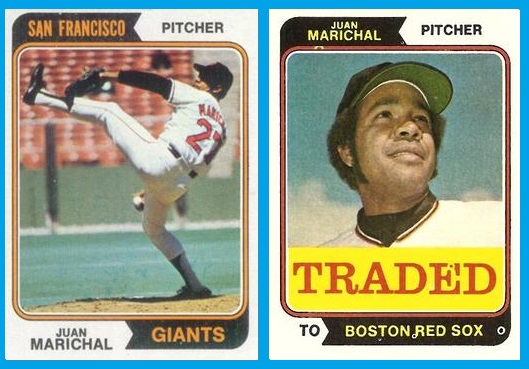
The Traded design is a bit of an eyesore, and the subset includes only two Hall of Famers, Marichal and Santo. For a bit more star power, we only need to look two years earlier.
1974 Kellogg’s
Since I featured Marichal with the Topps card, we’ll go with Santo here. By now you know the drill on Kellogg’s. The team name/logo is updated, and there is a Traded line, though it’s very hard to read on this particular scan.
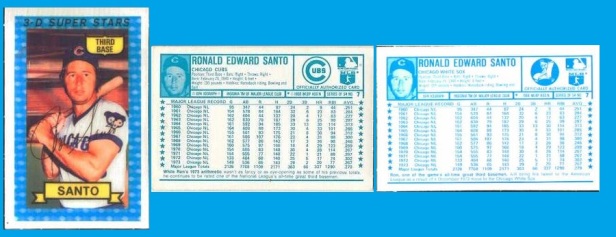
1972 Topps Traded
As part of the high number series in 1972, Topps included seven cards to capture what the card backs described as “Baseball’s Biggest Trades.”

The star power is immense, though some collectors see this subset more as a case of what might have been. One of the seven trades featured was Nolan Ryan-for-Jim Fregosi. However, as the bigger name at the time, Topps put Fregosi rather than Ryan on the card.
Net54 member JollyElm also reminded me about another big miss from Topps here. Yes, of course I’m talking about the Charlie Williams trade that had the San Francisco Giants already making big plans for October. “Charlie who?” you ask. Fair enough. Perhaps you’re more familiar with the player the Giants gave up for Williams.
Topps took a pass on this one, but–as always–Gio at When Topps Had (Base) Balls is here to take care of us.
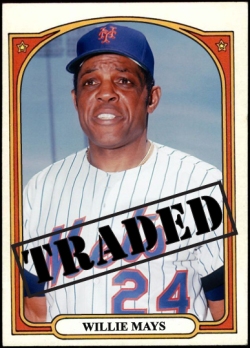
1972 O-Pee-Chee
This next example is not a Traded card, but it is one of the most unique Update cards in hobby history. RIP to the Quiet Man, the Miracle Worker…the legendary Gil Hodges.
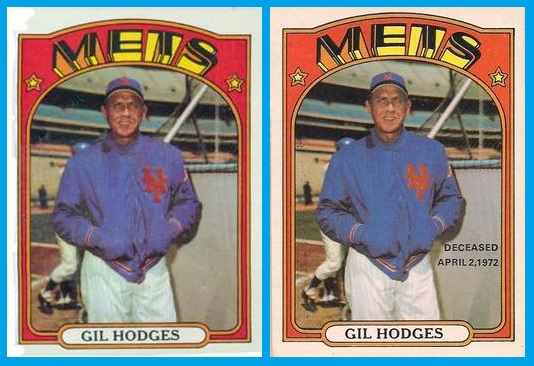
You might wonder if OPC gave its 1973 Clemente card a similar treatment. Nope. And if you’re wondering what other cards noted their subject’s recent demise, there’s a SABR blog post for that!
1971 O-Pee-Chee
Though the first Topps/O-Pee-Chee baseball card partnership came in 1965, the 1971 O-Pee-Chee set was the first to feature Traded cards. (The 1971 set also includes two different Rusty Staub cards, which was something I just learned in my research for this article.) My article on the Black Aces is where I first stumbled across this 1971 Al Downing card.
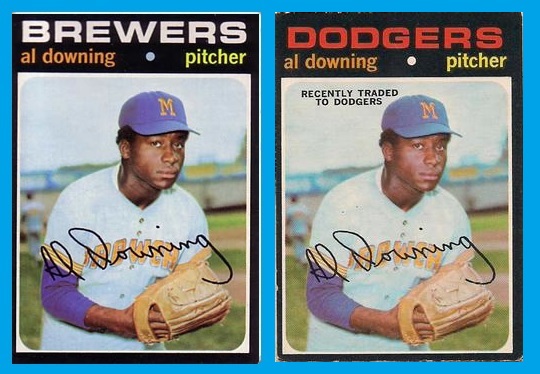
Where the 1972 OPC Hodges and 1979 OPC Rose cards were precise about dates, this one just goes with “Recently…” Of course this was not just any trade. Three years later, still with the Dodgers, Downing would find himself participating in one of the greatest moments in baseball history.
1969 Topps
At first glance, these two cards appear to be a case of the Bump Wills error, only a decade earlier. After all, Donn Clendenon never played a single game with the Houston Astros, so why would he have a card with them? However, this is no Bump Wills error. There is in fact a remarkable story here, echoing a mix of Jackie Robinson and Curt Flood. I’ll offer a short version of it below the cards.
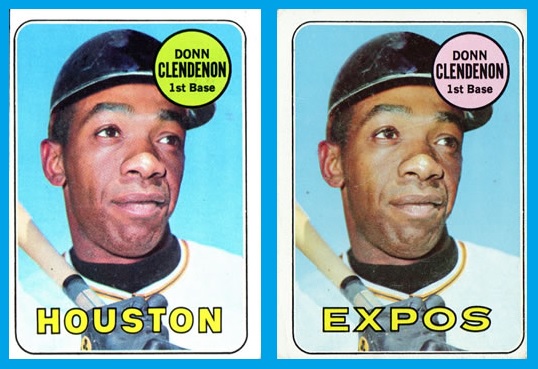
Donn Clendenon played out the 1968 season with the Pittsburgh Pirates, which explains his uniform (sans airbrush) in the photos. However, at season’s end he was selected by the Expos in baseball’s expansion draft. Still, that was a good six months before these cards hit the shelves so there was time for a plot twist.
Three months after becoming an Expo, Montreal traded Clendenon, along with Jesus Alou, to the Astros for Rusty Staub. Based on the trade, Topps skipped Montreal altogether and led off their 1969 offering with Clendenon as an Astro. But alas, Clendenon refused to report to Houston, where several black players had experienced racism on the part of the team’s manager, instead threatening to retire and take a job with pen manufacturer Scripto. Ultimately the trade was reworked, Clendenon was able to remain an Expo, and he even got a raise and a new Topps card for his trouble.
1966-1967 Topps
Thanks to Net54 member JollyElm for providing information on this set and providing the occasion to feature Bob Uecker to boot. While the card fronts in these years gave no hints of being traded cards the backs indicated team changes in later printings. Here is an example from each year. In 1966, the only change is an added line at the end of the bio whereas 1967 has not only the added bio line but also update the team name just under the player name area.
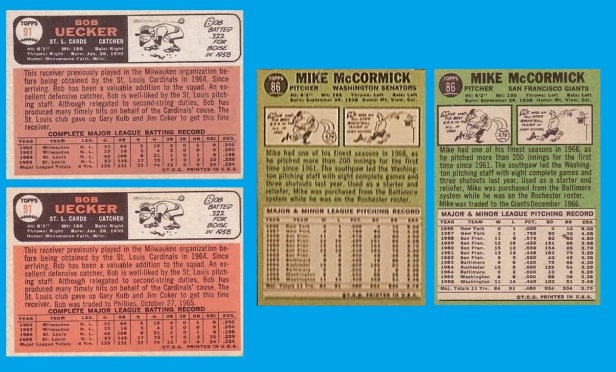
Note that the corresponding OPC card backs follow the later (traded) versions of the Topps cards.
Topps League Leaders – 1960s and beyond
In August 2018 Net54 member Gr8Beldini posted a particularly devious trivia question. The subject was players whose Topps League Leaders cards depicted them on different teams than their base cards in the same set.
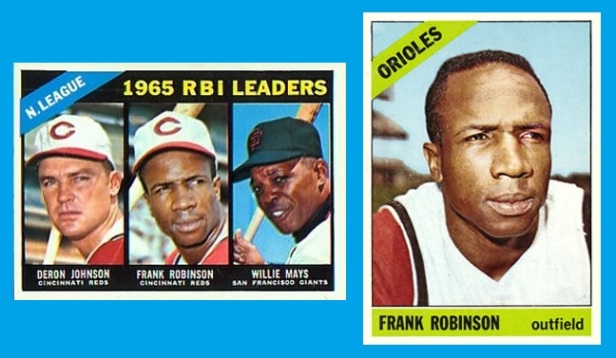
These 1966 Frank Robinson cards are among 11 instances where this occurred in the 1960s and 70s. If you can name the other 10, all I can say is you REALLY know your baseball cards!
1961-1963 Post Cereal
We’ll start with the 1962 and 1963 issues, which feature the now familiar Traded lines. Note however that there were no prior versions of these same cards minus the Traded line. Roberts is from the 1962 set, and McDaniel is from the 1963 set.
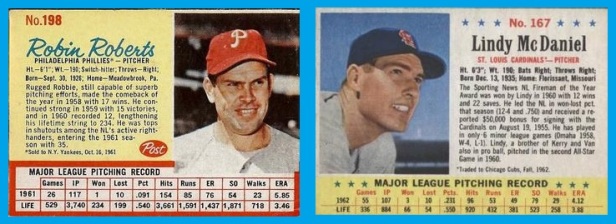
Post mixes it up a bit more in 1961 in that there were numerous variations between cereal box versions of the cards and mail-in order versions. The Billy Martin cereal box version (left) lacks a Traded line, but the mail-in version (right) indicates Martin was sold to Milwaukee in 1960.

BTW, thank you to Net54 member Skil55voy for pointing me to the Post Cereal variations.
1959 Topps
Thanks to Net54 member RobDerhak for this example, which follows (really, precedes) the examples from 1966-67 Topps. Note the last line of the bio on the second card back: “Traded to Washington in March 1959.” (You might also enjoy an unrelated UER on both backs. See if you can find it!)
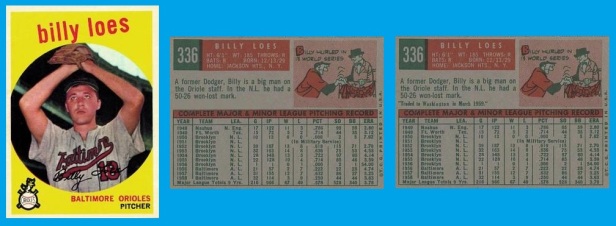
1956 Big League Star Statues
A tip of the hat to Net54 member JLange who took us off the cardboard and into the a fantastic set of early statues, possible inspirations for the Hartland figures that would soon follow and an early ancestor of Starting Lineup. Doby’s original packaging puts him with his 1955 club (CLE), but later packaging shows his 1956 club (CHW).
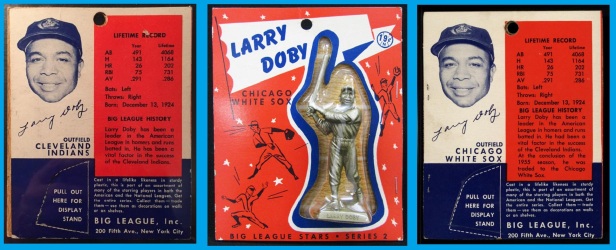
1955 Bowman
You know those Traded lines that O-Pee-Chee seemed to invent in the 1970s, at least until we saw them from Topps on the card backs of their 1967, 1966, and 1959 sets? Well, guess who the real inventor was?

1954 Bowman
Bowman’s Traded line didn’t make its debut in the 1955 set, however. Here is the same thing happening with their 1954 issue.
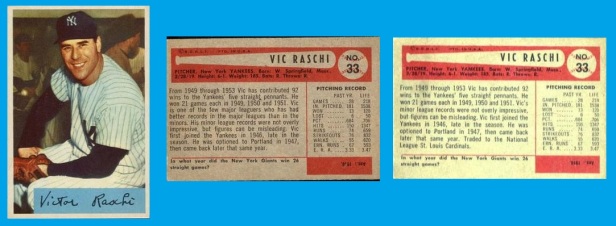
Is this the first set to add a “traded line” to the front or back of a card? As it turns out, no. But before showing you the answer, we’ll take a quick detour to another early 1950s issue that included team variants.
1954 Red Man
George Kell began the 1954 season with the Red Sox but moved to the White Sox early in the season. As a result, Kell has two different cards in the 1954 Red Man set. There is no “traded line,” but the Red Man artists did a reasonably nice job updating Kell’s uniform, and the team name is also updated in the card’s header information.
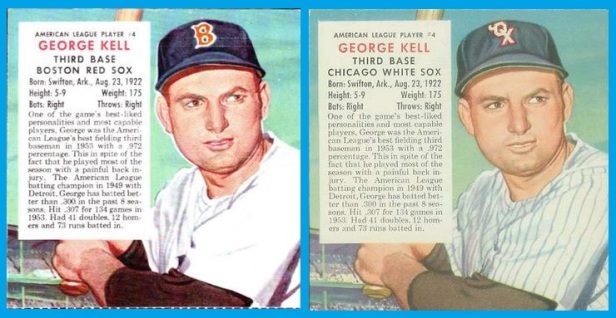
Red Man followed the same approach in moving outfielder Sam Mele from the Orioles to the White Sox. Meanwhile, Dave Philley, who changed teams prior to the start of the season, enjoyed those same updates and a traded line.
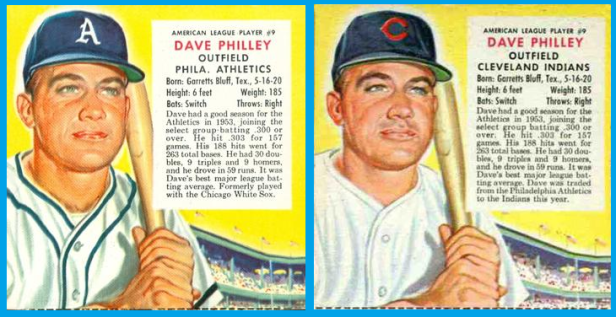
1951 Topps Red Backs
Notice anything different about these two Gus Zernial cards?
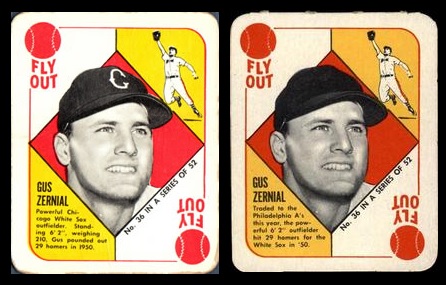
Yep, not only does the Chicago “C” disappear off his cap, but the bio on the second card begins, “Traded to the Philadelphia A’s this year.” So there you have it. At least as far as Topps vs. Bowman goes, Topps was the first to bring us the Traded line. And unlike so many of the examples we’ve seen from 1954-1967, it’s even on the front of the card!
1947-1966 Exhibit Supply Company
If there’s anything certain about issuing a set over 20 years is that some players are going to change teams. As such, many of these players have cards showing them playing for than one team (or in the case of Brooklyn/L.A. Dodgers more than one city.) Take the case of Harvey Kuenn, who played with the Tigers from 1952-1959, spent 1960 in Cleveland, and then headed west to San Francisco in 1961.
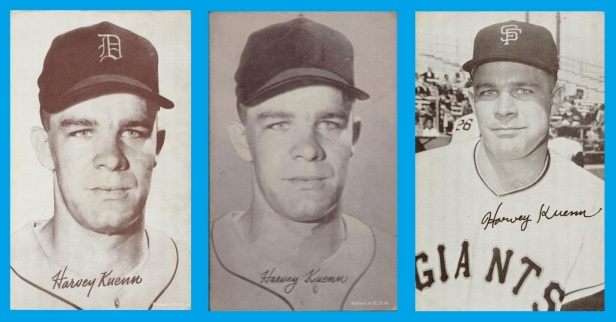
The plain-capping approach used in the middle card might lead you to believe that the Exhibits card staff lacked the airbrushing technology made famous by Topps or the artistic wizardry you’ll soon see with the 1933 Eclipse Import set. However, their treatment of Alvin Dark’s journey from the Boston Braves (1946-1949) to the New York Giants (1950-1956) actually reveals some serious talent. (See how many differences you can spot; I get five.) I almost wish they just went with it for his Cubs (1958-1959) card instead of using a brand new shot, which somehow looks more fake to me than his Giants card.

1948 Blue Tint
In researching my Jackie Robinson post, I came across this set of cards from 1948. Among the variations in the set are the two cards of Leo the Lip, who began the year piloting the Dodgers but finished the year with their National League rivals. No need to take another picture, Leo, we’ll just black out the hat!
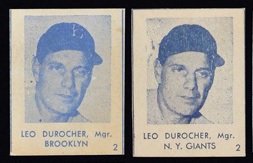
1934-36 Diamond Stars
We’re going way back in time now to capture a Traded card sufficiently under the radar that even Trading Card Database doesn’t yet list it. (UPDATE: It does now, but PSA does not!) Its relative obscurity might lead you to believe it’s a common player, but in fact it’s Hall of Famer Al Simmons.

After three years with the Chicago White Sox, Bucketfoot Al joined the Detroit Tigers for the 1936 season. As a set that spanned three years, Diamond Stars was able to update its Simmons card to reflect the change. The cards appear similar if not identical at first glance. However, the Tigers card omits the Sox logo on Al’s jersey, and the card reverse updates Al’s team as well.
Another Hall of Famer with a similar treatment in the set is Heinie Manush. Some collectors are familiar with his “W on sleeve” and “no W on sleeve” variations. These in fact reflect his move from the Senators to the Red Sox. This set has so many team variations, most of which are beneath the radar of most collectors, that I’ll give the topic its own post sometime soon. (UPDATE: Here it is!)
1933 Goudey
The 1933 Goudey set included some late-season releases, including a tenth series of 24 cards that included key players from the 1933 World Series. Even the most casual collectors know the Goudey set included more than one card of certain players–most notably four of the Bambino. What not all collectors realize is that the set includes a Traded card.

Hitting great Lefty O’Doul was originally depicted as a Brooklyn Dodger, the team he played with until mid-June of the 1933 season. However, when the final release of trading cards came out, Lefty had a new card with the World Champion New York Giants.
Of course, if Lefty’s .349 lifetime average isn’t high enough for you, there is an even better hitter with a traded card in the set. His move from the Cards to the Browns on July 26 prompted a brand new card highlighting not only his new team but his new “position” as well.

1933 Eclipse Import
Another hat tip to Net54 member JLange who offered up a set not even listed yet in the Trading Card Database. Also known as R337, this 24-card set may be where you’ll find one of the most unusual Babe Ruth cards as well as this priceless update. Not technically a Traded card since the player is with Cleveland on both cards (and was with the Tribe continuously from 1923 until midway through the 1935 season), but…well, first take a look for yourself, and then meet me on the other side!
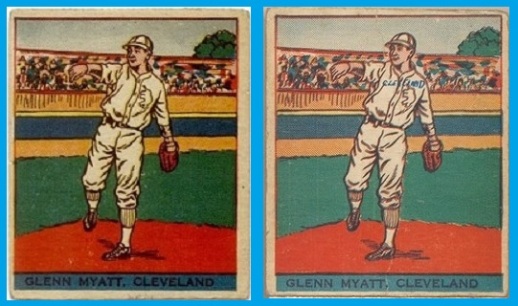
Yes, that is the Philly mascot on Myatt’s uniform. After all, he played for Connie Mack’s squad back in…wait for it…1921! But no problem. Let’s just find someone with pretty neat handwriting to scribble Cleveland across the uni on our next go-round. Problem solved!
1927 Exhibits
My thanks to Net54 member Peter_Spaeth (whose worst card is 100x better than my best card!) for tipping me off to this set and allowing me to use his card of Old Pete. In a move that perhaps inspired future O-Pee-Chee sets, here is Grover Alexander, Cubs uniform and all, on the St. Louis Cardinals.
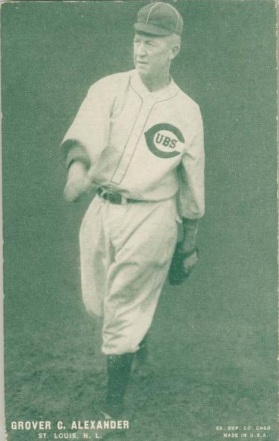
Other HOFers with mismatched teams and uniforms are Ty Cobb, Rogers Hornsby, and Tris Speaker. In case you haven’t guessed it already, if you want to see a ton of star power on a single checklist, you owe it to yourself to take a look at the HOFers in this set.
1914-1915 Cracker Jack
If you view the 1914 and 1915 Cracker Jack sets as two different sets (that happen to have a gigantic number of nearly identical cards), then there are no Traded cards. However, if you view the two releases as a single set, then there are numerous Traded cards. Among the players to appear on two different teams, the biggest star is unquestionably Nap Lajoie. who appears in 1914 with his namesake Cleveland Naps and in 1915 with the Philadelphia Athletics. In addition to the change in the team name at the bottom of the card, you can also see that “Cleveland” has been erased from his jersey.
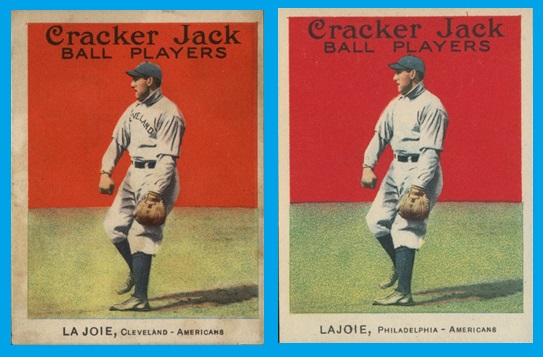
Another notable jumper in this set is HOF pitcher Eddie Plank who has his 1914 card with the Philadelphia Athletics and his 1915 card with the St. Louis Terriers of the Federal League.
1911 T205
I will take any excuse to include cards from this set in a post, so I was thrilled when Net54 member Gonzo alerted me to the team variations in this set. Here are two players who were traded from the Boston Rustlers (who?) to the Chicago Cubs. David Shean went packing on February 25, 1911, and George “Peaches” Graham made his move a few months later on June 10.
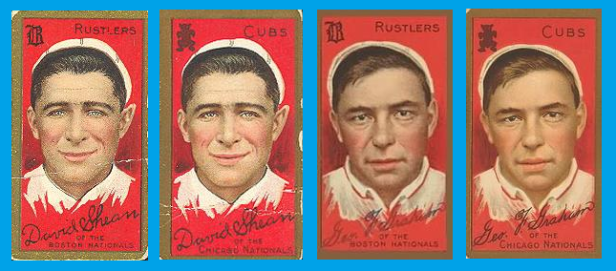
Gonzo also notes that many of the images from the 1911 T205 set were reused, uniforms and all, for the 1914 T330-2 Piedmont Art Stamps set. (I will freely admit to never having heard of this issue.) One HOF jumper is double-play man Johnny Evers, whose picture has him on the Cubs but card has him on the Braves. There are also several players attached to Federal League teams though their images still show their NL/AL uniforms.
1911 S74 Silks
It was once again Net54 member Gonzo for the win with this great find! On the other end of the aforementioned “Peaches” Graham trade was Johnny Kling, depicted here in his Cubs uniform while his card sports the Boston Rustlers name and insignia.
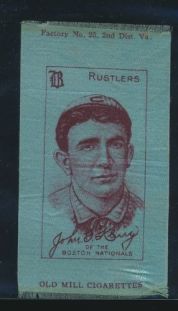
1909-11 T206
Another multi-year set, the Monster includes a handful of team change variations. The Bill Dahlen card on the left shows Dahlen with his 1909 team, the Boston Braves. Though he would only play four games total over his final two seasons in 1910 and 1911, the cardmakers at the American Tobacco Company saw fit to update his card to show his new team, the Brooklyn Dodgers.
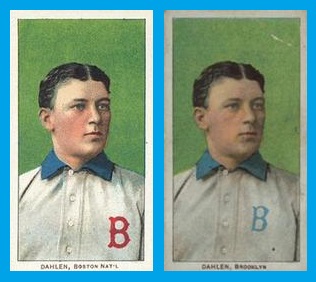
1887-90 Old Judge
If T206 isn’t old enough for you, then let’s go even farther back to the juggernaut of 19th century baseball card sets, N172, more commonly known as Old Judge. According to Trading Card Database, Hall of Fame pitcher Amos Rusie has cards with both the Indianapolis Hoosiers (1887) and the New York Giants (1889-90). I was unable to find what felt like a real NYG card of Rusie, but I did find one where a strip of paper reading “New York” had been glued over the area of the card that had previously said “Indianapolis.” My immediate thought was that a collector was the culprit behind this cut-and-paste job. But how funny would it be if this is how the Old Judge cardmakers did updates back then!
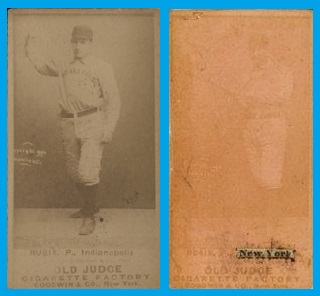
Epilogue
When I first stumbled across Traded cards, it was love at first sight. What a thrill to end up with two cards of a top star, and what better way to turn a common player into a conversation starter. To the extent baseball cards tell a story and document the game’s history, Traded cards hold a special role. Unfortunately, these cards have a dark side as well. At least in 1983 they did. If you ever doubted that 8 3/4 square inches of cardboard could rip a kid’s heart out, stomp it to bits, and then spit all over it, well…here you go.
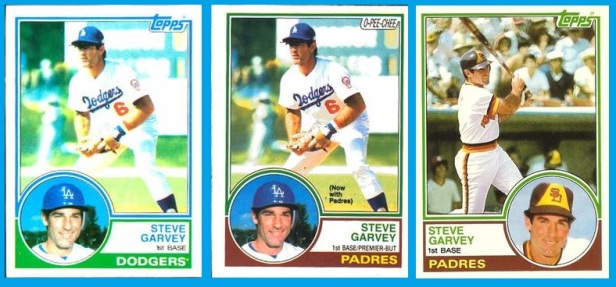
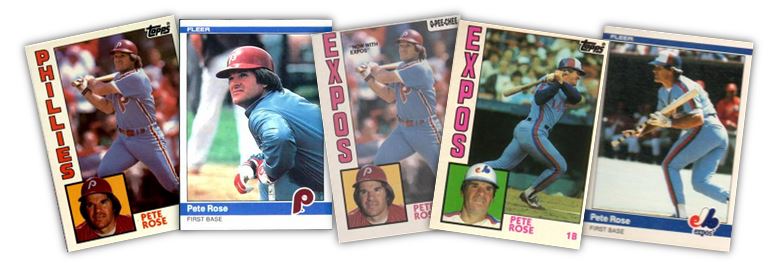
Kellogg’s added some traded lines on a few of their cards. In 1977 variations exist that mention trades on the cards of Ken Reitz (#38) and Wayne Garland (#21).
LikeLiked by 1 person
6Fantastic! I will make that addition. Thanks so much for the tip.
LikeLike